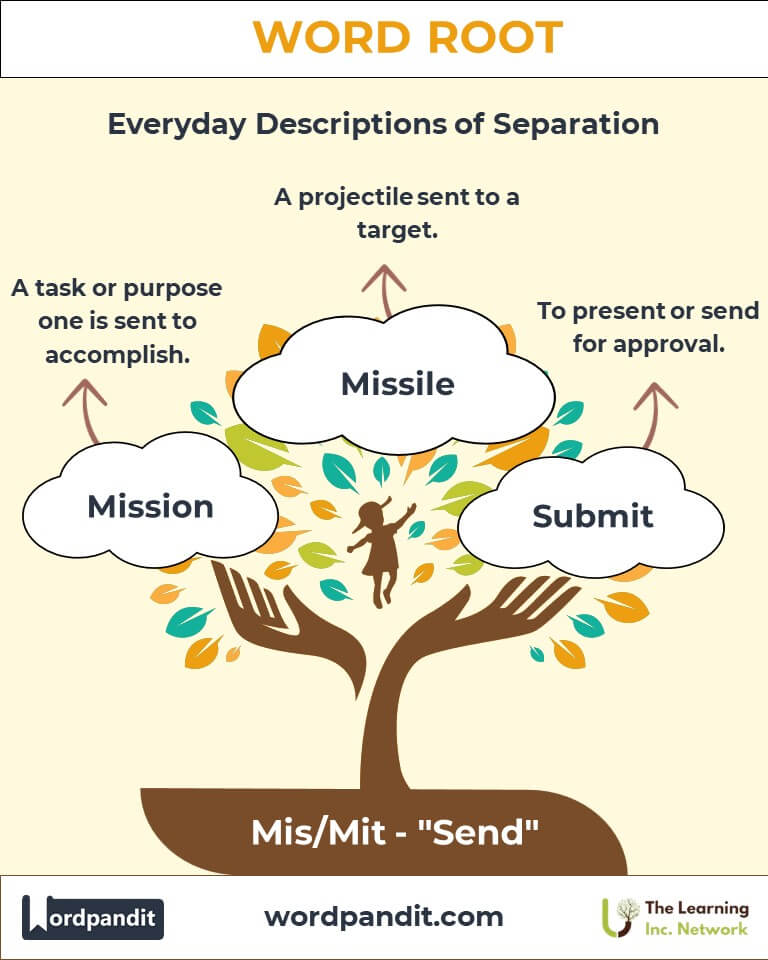Mis, Mit: The Roots of Sending and Communication
Explore the linguistic journey of the roots "mis" and "mit," meaning "send," and their profound influence on language and communication. From everyday words like "transmit" to impactful concepts like "missiles," these roots reveal the foundational role of sending in connecting and impacting the world.

Table of Contents
- Introduction: The Essence of Mis and Mit
- Etymology and Historical Journey
- Mnemonic: Unlocking the Power of Mis and Mit
- Common Mis/Mit-Related Terms
- Mis and Mit Through Time
- Mis and Mit in Specialized Fields
- Illustrative Story: Mis/Mit in Action
- Cultural Significance of Mis and Mit
- The Mis/Mit Family Tree
- FAQs About the Mis, Mit Word Root
- Test Your Knowledge: Mis, Mit Word Root Quiz
- Conclusion: The Living Legacy of Mis and Mit
Introduction: The Essence of Mis and Mit
Have you ever wondered why "mission" means a task to be sent on, or how "transmit" conveys the act of sending across? The roots "mis" and "mit," both derived from Latin, mean "send." Pronounced as "miss" and "mitt," these roots form the backbone of numerous words that signify movement, communication, or action. From launching a missile to submitting a form, "mis" and "mit" highlight humanity’s intrinsic need to send, share, and connect.

Etymology and Historical Journey
The roots "mis" and "mit" originate from the Latin word mittere, meaning "to send." Early uses were often literal, referring to physical dispatching of people, goods, or messages. Over time, these roots evolved to include metaphorical meanings, such as transferring ideas or emotions.
In the Middle Ages, terms like "mission" emerged, reflecting religious endeavors to spread faith. The Industrial Revolution expanded "mis/mit" into technological contexts, giving rise to terms like "transmit" and "emission." Today, these roots remain integral in describing everything from communication to space exploration.
Mnemonic: Unlocking the Power of Mis and Mit
Imagine a missile flying through the air, a literal representation of sending something across great distances. Now picture a letter being submitted, a peaceful yet purposeful act of sending. These vivid images help encapsulate the dual nature of "mis" and "mit."
Mnemonic Device:
"Mis/Mit missions send messages or missiles into the world."
Common Mis/Mit-Related Terms
- Missile (MIS-sil):
Definition: A projectile sent to a target.
Example: "The defense system intercepted the incoming missile." - Transmit (TRANS-mit):
Definition: To send across or transfer.
Example: "The radio tower transmits signals across the region." - Mission (MISH-un):
Definition: A task or purpose one is sent to accomplish.
Example: "The astronaut's mission was to repair the satellite." - Submit (sub-MIT):
Definition: To present or send for approval.
Example: "Please submit your application by the deadline." - Emit (ee-MIT):
Definition: To send out, as in sound or light.
Example: "The lamp emits a soft, warm glow." - Omit (oh-MIT):
Definition: To leave out or fail to send.
Example: "He omitted an important detail from the report."
Mis and Mit Through Time
- Missive (Medieval): Referring to a letter or written message sent to someone.
Evolution: Once formal, it now serves poetic or historical contexts. - Intermission (Theatrical Revolution): A break sent into performances to allow rest.
Shift: Its application broadened to include breaks in any activity. - Admit (Modern Legal/Medical): To send or allow someone into a place, like a hospital or court.
Usage Today: The term carries connotations of acceptance or acknowledgment.
Mis and Mit in Specialized Fields
- Technology:
Transmit: Critical in data and communication systems, describing signal transfer.
Example: "Fiber optics transmit data at lightning speeds." - Space Exploration:
Missile: Initially military, the term now includes rockets sent into orbit.
Example: "The missile carried scientific instruments to study the atmosphere." - Medicine:
Emit: Describes radiation or waves sent during imaging procedures.
Example: "X-ray machines emit controlled radiation to capture images." - Legal:
Admit: Refers to accepting evidence or individuals into legal proceedings.
Example: "The court admitted new evidence for review."
Illustrative Story: Mis/Mit in Action
In a bustling newsroom, journalist Clara received a missive from a source about a groundbreaking story. After verifying the details, she transmitted her report to the editorial team. Her editor, impressed, asked her to submit it for publication. The next day, the news outlet emitted a special broadcast that reached thousands. Clara realized how these small acts of sending—guided by the power of "mis" and "mit"—had impacted countless lives.
Cultural Significance of Mis and Mit
The act of sending is fundamental to human culture, from ancient messages carried by doves to modern texts transmitted instantly. The roots "mis" and "mit" embody this timeless need to connect. They are present in diplomatic missions, artistic submissions, and technological emissions, reminding us of our shared pursuit of communication and understanding.

The Mis/Mit Family Tree
- Port (carry):
- Export: To carry goods out of a country.
- Import: To bring goods into a country.
- Graph (write):
- Telegraph: A written message sent over long distances.
- Autograph: A signature sent as a personal mark.
- Duc (lead):
- Conduct: To lead or send along a path.
- Deduce: To send reasoning towards a conclusion.

FAQs About the "Mis" and "Mit" Word Roots
Q: What do "mis" and "mit" mean?
A: The roots "mis" and "mit" mean "send," derived from the Latin word mittere. These roots are used in words that describe acts of sending, transferring, or dispatching something, such as "transmit" or "mission."
Q: Are "mis" and "mit" interchangeable?
A: Yes, they are interchangeable as they come from the same root. However, their usage depends on the word and context. For example, "mission" uses "mis," while "admit" uses "mit." This variation is influenced by historical linguistic developments.
Q: What’s the difference between "omit" and "emit"?
A: While both words derive from the same root, their meanings diverge significantly. "Emit" means to send out, like light or sound (e.g., "The lamp emits light"). "Omit" means to leave out or fail to include (e.g., "He omitted an important detail").
Q: How does "transmit" differ from "submit"?
A: Both involve sending but differ in intent. "Transmit" means to send across or transfer (e.g., "The satellite transmits signals"). "Submit" means to present something for approval or judgment (e.g., "Please submit your assignment by Friday").
Q: Why is "missile" related to "mis"?
A: The word "missile" comes from the Latin missilis, meaning "that which is sent." It describes an object designed to be launched or propelled toward a target, highlighting the root's connection to sending.
Test Your Knowledge: Mis and Mit Mastery Quiz
1. What does "mit" mean?
2. Which word means "to present for approval"?
3. What does "omit" mean?
4. Which field uses "emit" frequently?
5. Which word describes a task someone is sent to do?
Conclusion: The Living Legacy of Mis and Mit
The roots "mis" and "mit" showcase the enduring importance of sending in human expression and innovation. From simple acts like mailing a letter to complex feats like transmitting data across galaxies, they connect us to one another and the wider world. As technology advances, "mis" and "mit" will continue to shape how we send, share, and communicate. Let their legacy inspire you to explore new ways of connecting!












